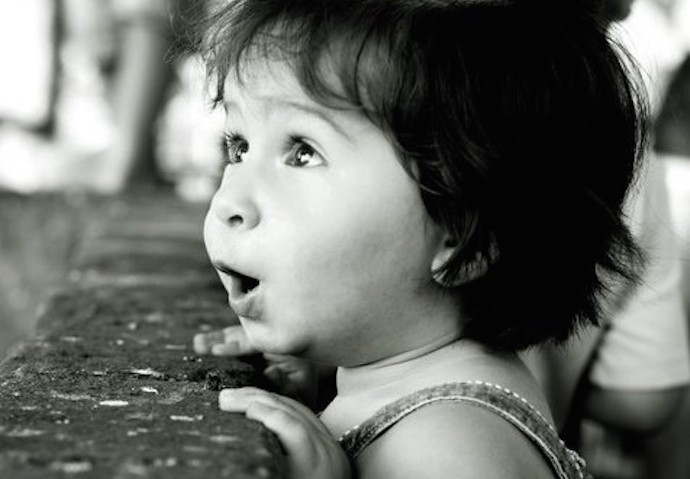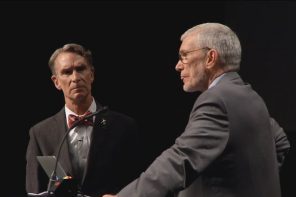“Spirituality may not speak to you at all,” Lisa Miller writes near the beginning of her new book, The Spiritual Child. “But it is foundational to your child.” Miller is a psychologist at Columbia University whose research focuses on how personal spiritual experiences shape the development of children and adolescents.
In The Spiritual Child, Miller draws on decades of research to argue that spirituality is important for children’s well-being and protective against depression, substance abuse, and other dangers. Miller approaches spirituality with a tactical pragmatism. The question here isn’t whether or not spiritual experience is verifiable. Instead, the questions are: does spiritual experience have verifiable benefits? And, if so, what should we do about that?That can be contentious territory, and Miller is keen to emphasize that this is “all in the science”—specifically, “established scientific fact” that’s “grounded in the science” and “the picture created by science,” now made available so that parents can make decisions “grounded in science and in our natural love.” In the book’s 20-page introduction (from which all five of those quotes are pulled), Miller uses variations of the word “science” sixty-eight times.
Unfortunately, the book’s sourcing doesn’t entirely bear out its own claims to scientific rigor. Shortly after The Cubit spoke with Miller, The Daily Beast published a review of The Spiritual Child highlighting errors and shaky interpretations. As reviewer Vlad Chituc (who, in full disclosure, is a friend) points out, Miller misrepresents key details of a study by the psychologist Paul Bloom. She also cites a pair of studies from The Journal of Alternative and Complementary Medicine—one involving psychic communication, and the other discussing energy fields—neither of which is an acceptable source for a work that purports to be scientific.
For an academic researcher, this presents serious questions, and we considered not publishing the following Q&A. But these missteps don’t involve Miller’s own research, and, despite the dubious sourcing, a number of Miller’s claims are persuasive. There is evidence—much of it from Miller’s own, peer-reviewed work—that self-reported spiritual experience lowers the risk for substance abuse, depression, and unprotected sex among adolescents. There’s also plenty of evidence that adolescents can use spiritual experiences and techniques to navigate emerging adulthood, a process Miller discusses in depth.
Over the phone, Miller spoke with The Cubit about adolescence, definitions of spirituality, and the reframing of spiritual experience as a pragmatic tool.
This interview has been edited for clarity and length.
So how are science and spirituality interacting here?
Science is actually an elegant way for understanding spirituality. It connects what so many devout people have known through the heart with what we can collectively witness through the lens of science. In the same way that we honor and listen to the testimony of [individuals], when we look through the lens of science we’re listening to a whole chorus of voices—to a whole group of people expressed through a collection of data of points. It’s a chorus of voices offering witness. I view science as essential on my own spiritual path.
When we think of science tackling spiritual topics, it’s usually in the context of Big Questions about life and the cosmos. Looking at the effect of spirituality on an individual is a very different kind of approach.
What I am looking at in The Spiritual Child is a very powerful body of science on spiritual life.
Looking at hundreds of studies, we can say three things. They are not my opinion. They are in the science.
The first is that human beings are born innately spiritual. We have a natural capacity through which we experience transcendence and the relationship with the higher power. [Second], we look at optimal functioning and we see that we are healthier at every level of analysis. Whether we’re looking at the brain, the cell, or the whole human life course, we are healthier and function optimally with a strong spiritual life. The third way is we can look at markers of health and wholeness, for instance in the brain. In JAMA in 2014, I was the first author on an article that showed a thicker cortex, which is processing power associated with IQ and health, in people with a strong personal spirituality over time.
Spirituality is an extraordinary protection against the most prevalent forms of suffering. Young people in the first two decades [of life] very rarely die of cancer or diabetes. They die of risk-taking and suicide, things like that. And there’s nothing in the medical sciences as robust and protective against the most serious forms of suffering and risk as a personal spirituality.
There’s the term “spirituality,” as we use in ordinary conversation, which is fairly vague. But for research, you need to have the term locked down. How does our day-to-day use of “spirituality” differ from the definition you use in the lab?
Spirituality comes for many people within their religious tradition, and for many other people spirituality comes outside their religious tradition. There’s a very broad range of spiritual experiences. The piece that I focus on in The Spiritual Child is a direct relationship with a higher power, whether that is in the language of God, Allah, Hashem—whatever the language may be, whether it’s Judeo-Christian at all.
That living transcendent relationship is, according to science, where the greatest protective benefits are found. There are other spiritual and religious paths that support that, and interact with that. For instance, going to church or temple supports the development of a personal relationship, a transcendent relationship. A parent supports the relationship.
But at the end of the day, the strongest source of thriving and health, the dimension of spirituality with the greatest footprint on our health and thriving, is specifically the transcendent relationship, the relationship with the higher power.
In the lab, how do you determine that someone is having what you would call a “transcendent spiritual relationship”?
The transcendent relationship was first measured starting in the late ‘90s. The best study to come out was Kenneth Kendler’s in 1997, and then again in 1999. They simply asked people to self-report, which turned out to be extremely valid when you’re talking about self-experienced spirituality.
One thing we found was that a sense of living in a sacred world, or simply saying spirituality is important to me, is always highly correlated with that personal relationship. It’s the portal through which opens a sacred world. That’s the sense, in the West. Again, in the East, it’s often a sense of oneness, of feeling part of the life force, part of a way.
Dozens and dozens of studies send a clear signal that that personal relationship with God is 80% protective against risky sex in girls. It’s 40% protective against substance abuse in kids, as compared to someone who’s just average. A highly spiritual kid, as compared to someone who doesn’t feel any spirituality at all, is 80% protected against substance abuse. There’s nothing like this in the epidemiological or clinical research. It’s jaw dropping. And it drove me nuts, as a parent, that I didn’t see other parents benefiting from this. I could see it clear as day every day in my lab, and it wasn’t crossing the barrier of the lab.
I grew up in the Bible Belt. There were lots of opportunities to cultivate “transcendent spiritual relationships,” and I think we probably didn’t use quite as many substances, or have quite as much premarital sex, as kids growing up in, say, New York. But I’m not sure that had to do with spiritual experience so much as a less permissive (or more repressive) culture. How do you separate out the effects of personal spiritual experience from the effects of the broader culture? Correlation from causation?
This personal transcendent relationship happens within or without of religion. It is part of our birthright, it is part of our nature. The rigid adherence to creed was also identified in the 1997 paper by Kendler—a close and rigid adherence to creed. And that is not protective against substance abuse. It has a small effect in preventing kids from ever trying substances, but once that boundary is crossed, it is not protective against heavy use, it is not protective against downward slide or abuse.
Similarly, in our study, we look at a large study of adolescent girls. That deep spiritual piece puts sex in the context of relationships and love. Girls who have a strong relationship with a higher power tend to have more stable ongoing relationships, fewer partners, and less exposure to dangerous sex. However, rigid adherence to creed actually poses risks for some girls to end up in situations that they weren’t ready for. Once the line is crossed, science does not show a protective benefit.
So you can separate it out?
You can. Yes, you can statistically separate them out. Overall, the personal relationship with God is deeply protective. The rigid adherence to creed has no protective benefits except first time exposure. All it does is slightly mitigates the likelihood that a teen will try substances, try sex, be in a dangerous place. But once they are, and they often are, there is no protective benefit against deep danger and slide into profound problems.
Do you think that spiritual people are ever uncomfortable seeing belief described in such pragmatic terms?
The person who was most moved by this of anyone was a deeply devout priest. I think it’s a tribute to the hunger of people to understand spirituality through our lived human existence.
I just wonder if I’ll be standing in synagogue one day and suddenly think, “Hey, this is making me 40% likelier to avoid drug addiction,” or whatever. That seemed like it might be a jarring experience.
Well, “its ways are ways of pleasantness, and all its paths are peace.” [Ed. –Proverbs 3:17; the verse is used widely today in Jewish liturgy, in reference to the Torah]. Those who keep Shabbat, Shabbat keeps them, right? I think it’s deeply entrenched in spiritual and religious life that the spiritual life, that the spiritual path, is also the path of thriving and flourishing and healing.
I don’t think it diminishes it. I don’t think it’s sacrosanct. I think it’s testimony.
How can parents balance the desire to have critical, questioning kids with a wish to encourage thinking that may not be entirely rational, or that may involve perceptions of entities that can’t be materially explained?
We have multiple ways of knowing: we have intuition, we have rigorous logic, we have investigation. We need to use them all. They’re all important, valid forms of perception.
We see epidemic rape on campuses, of depression that is not major depression, it’s not clinical major depression, it’s a developmental growing depression. It’s the moving up and asking, what is my meaning, what is my purpose? And you can run that question in your head for 70 more years and not get an answer.
But if you allow the question of what is my meaning, what is my purpose, what’s ultimate meaning and purpose? to be responded to by the heart, there can be a synthesis of deep-felt wisdom, a deep-felt clarity. That’s real. That’s not less real because it involves multiple forms of knowing. It makes full use of the human instrument to engage in life.






